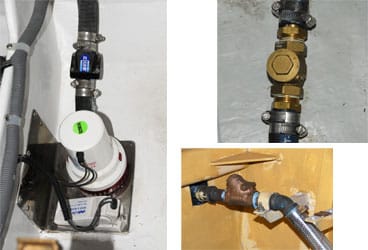
check valves
Check valves are commonly found in several of the systems aboard a sailboat devoted to making sure that various liquids flow in the directions they’re supposed to. It’s helpful to understand how these devices work and whether they’re suitable for the tasks at hand.
These valves are usually found in water and some sanitation systems and in most water and effluent pumps. In fuel systems, they may be used to prevent fuel or air from flowing backward from a vent to the engine; in potable-water systems, check valves are often used on the supply side of a water heater to prevent it from inadvertently draining and burning out the electric heating element in the event of a leak in the incoming line.
In some applications, check valves may also be used in a vessel’s exhaust system to prevent water from flowing in the wrong direction up an exhaust pipe while under sail. In their simplest form, these valves often consist of the familiar—and sometimes missing—rubber flap attached to the outlet of a main engine or generator where the exhaust pipe pokes through the hull near the waterline. More sophisticated versions are installed in-line with the exhaust plumbing, where too often they can’t be seen or inspected.
There are two primary types of check valves used in raw-water systems, including those that drain the bilge. The most common is the swing check valve, typically made of bronze, which uses a metallic gate or door that freely opens when fluid flows in one direction and slams shut when the flow tries to reverse. Swing check valves can also be found with a plastic body and a rubber gate.
Another style of valve uses a spring-loaded disc located in the fluid stream. Fluid pressure compresses the spring, pushing the disc back into the valve body and opening up a path for the liquid to flow around it. Backflow seals the valve shut.
Where check valves often go awry is in bilge-pump applications, because they have a propensity to become lodged either open or closed, particularly when used infrequently or when debris in the bilge makes it through a strainer. Either case can prove disastrous. The key is to make sure that you can access the valve and that a way exists to clear it out.
Take note: Because check valves can malfunction, using one to prevent downflooding is clearly prohibited by guidelines drawn up by the American Boat & Yacht Council. Therefore, if the bilge-pump discharge is located below the waterline, either at rest or during any state of heel, a check valve must not be all that stands between the bilges and the water outside. Additionally, check valves may not be used to prevent backflooding in systems that utilize an overboard manifold or two outlets plumbed to a single overboard discharge hose.
Check valves also may prevent some electric bilge pumps from operating because the weight of the water contained in the hose after the check valve closes is too great for the pump to overcome to reopen the valve. This problem is insidious in that the pump will run and make turbulence in the standing water in which it rests, leading a casual observer to believe it’s working when in fact it’s not actually pumping.
Finally, inserting a check valve into any bilge-pump discharge hose can easily diminish the pump’s output by 50 percent. Where bilge pumps are concerned, anti-siphon valves are a preferable alternative to prevent backflow.
Steve D’Antonio offers services for boat owners and buyers through Steve D’Antonio Marine Consulting (www.stevedmarineconsulting.com).








